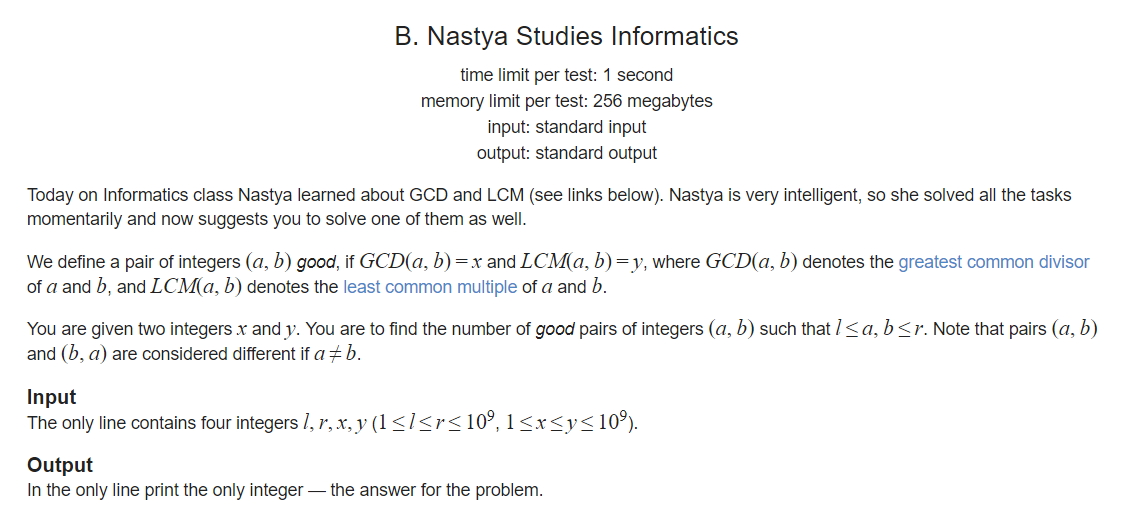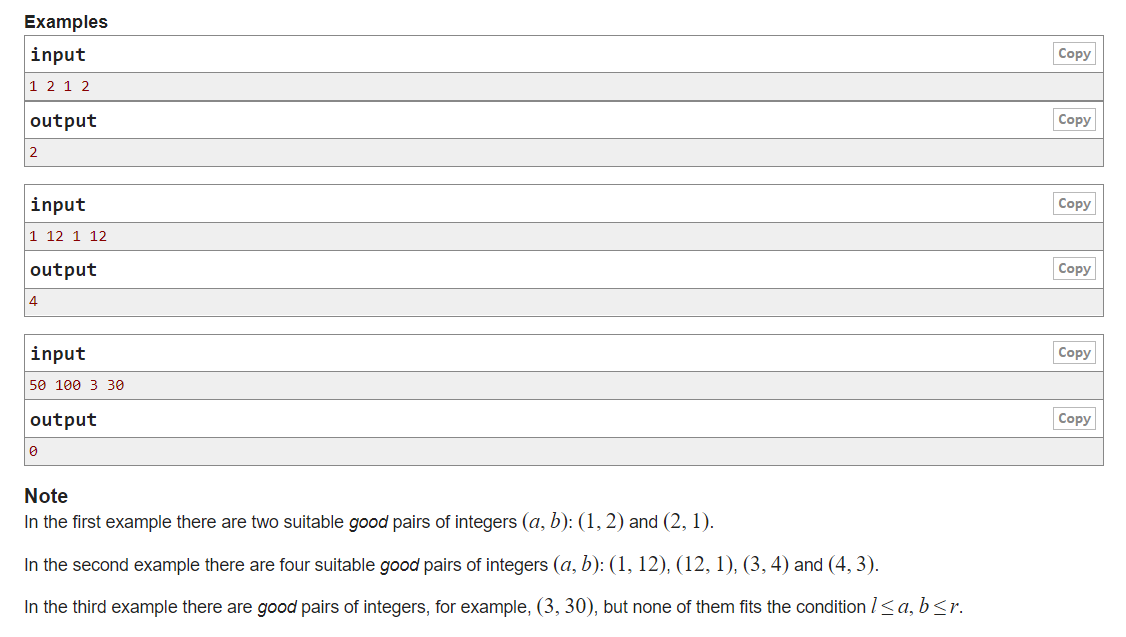http://codeforces.com/problemset/problem/992/B


题意:
给你区间[l,r]和x,y 问你区间中有多少个数对 (a,b) 使得 gcd(a,b)=x lcm(a,b)=y ,如果a,b交换位置就是不同的数对
思路:
根据lcm(最小公倍数) 的定义 y=a*b/x; 也就是说 x∗y=a∗b ;
那么 ,我们发现a,b一定为y的因数,所以我们枚举y的每个因子就可以,我们只要用log(y)的复杂度暴力算每一个因数就可以 ,
然后对于每个因子当做a, b=x*y/a; 然后判断a,b是否在区间内,gcd(a,b)是否为x,(注意要判断是否等于b)
1 #include <stdio.h> 2 #include <string.h> 3 #include <iostream> 4 #include <string> 5 #include <math.h> 6 #include <algorithm> 7 #include <vector> 8 #include <stack> 9 #include <queue> 10 #include <set> 11 #include <map> 12 #include <sstream> 13 const int INF=0x3f3f3f3f; 14 typedef long long LL; 15 const int mod=1e9+7; 16 //const double PI=acos(-1); 17 #define Bug cout<<"---------------------"<<endl 18 const int maxm=1e6+10; 19 const int maxn=1e5+10; 20 using namespace std; 21 22 LL gcd(LL a,LL b) 23 { 24 return b? gcd(b,a%b):a; 25 } 26 27 int main() 28 { 29 int l,r,x,y; 30 scanf("%d %d %d %d",&l,&r,&x,&y); 31 int ans=0; 32 for(LL i=1;i*i<=y;i++)//第一个因子 33 { 34 if(y%i==0) 35 { 36 LL j=x*(y/i); 37 if(i>=l&&i<=r&&j>=l&&j<=r&&gcd(i,j)==x) 38 ans++; 39 LL ii=y/i;//对应的另一个因子 40 if(i!=ii) 41 { 42 LL jj=x*(y/ii); 43 if(ii>=l&&ii<=r&&jj>=l&&jj<=r&&gcd(ii,jj)==x) 44 ans++; 45 } 46 } 47 } 48 printf("%d ",ans); 49 return 0; 50 }
Hankson的趣味题
Description
Hanks 博士是BT (Bio-Tech,生物技术) 领域的知名专家,他的儿子名叫Hankson。现 在,刚刚放学回家的Hankson 正在思考一个有趣的问题。 今天在课堂上,老师讲解了如何求两个正整数c1 和c2 的最大公约数和最小公倍数。现 在Hankson 认为自己已经熟练地掌握了这些知识,他开始思考一个“求公约数”和“求公 倍数”之类问题的“逆问题”,这个问题是这样的:已知正整数a0,a1,b0,b1,设某未知正整 数x 满足: 1. x 和a0 的最大公约数是a1; 2. x 和b0 的最小公倍数是b1。 Hankson 的“逆问题”就是求出满足条件的正整数x。但稍加思索之后,他发现这样的 x 并不唯一,甚至可能不存在。因此他转而开始考虑如何求解满足条件的x 的个数。请你帮 助他编程求解这个问题。
Input
输入第一行为一个正整数n,表示有n 组输入数据。
接下来的n 行每 行一组输入数据,为四个正整数a0,a1,b0,b1,每两个整数之间用一个空格隔开。输入 数据保证a0 能被a1 整除,b1 能被b0 整除。
接下来的n 行每 行一组输入数据,为四个正整数a0,a1,b0,b1,每两个整数之间用一个空格隔开。输入 数据保证a0 能被a1 整除,b1 能被b0 整除。
Output
输出共n 行。每组输入数据的输出结果占一行,为一个整数。
对于每组数据:若不存在这样的 x,请输出0; 若存在这样的 x,请输出满足条件的x 的个数;
对于每组数据:若不存在这样的 x,请输出0; 若存在这样的 x,请输出满足条件的x 的个数;
Sample Input
2 41 1 96 288 95 1 37 1776
Sample Output
6 2
HINT
样例说明
第一组输入数据,x 可以是9、18、36、72、144、288,共有6 个。
第二组输入数据,x 可以是48、1776,共有2 个。
数据规模和约定
对于 50%的数据,保证有1≤a0,a1,b0,b1≤10000 且n≤100。
对于 100%的数据,保证有1≤a0,a1,b0,b1≤2,000,000,000 且n≤2000。


题解:
https://www.cnblogs.com/five20/p/8434085.html
代码如下(无优化):
1 #include <stdio.h> 2 #include <string.h> 3 #include <iostream> 4 #include <string> 5 #include <math.h> 6 #include <algorithm> 7 #include <vector> 8 #include <stack> 9 #include <queue> 10 #include <set> 11 #include <map> 12 #include <sstream> 13 const int INF=0x3f3f3f3f; 14 typedef long long LL; 15 const int mod=1e9+7; 16 //const double PI=acos(-1); 17 #define Bug cout<<"---------------------"<<endl 18 const int maxn=1e5+10; 19 using namespace std; 20 21 LL gcd(LL a,LL b) 22 { 23 if(b==0) return a; 24 else return gcd(b,a%b); 25 } 26 27 int main() 28 { 29 int T; 30 scanf("%d",&T); 31 while(T--) 32 { 33 LL a,b,c,d; 34 scanf("%lld %lld %lld %lld",&a,&b,&c,&d); 35 if(a%b||d%c||d%b) 36 printf("0 "); 37 else 38 { 39 int num=0; 40 for(int x=1;x*x<=d;x++) 41 { 42 if(d%x==0) 43 { 44 if(x%b==0&&gcd(x/b,a/b)==1&&gcd(d/x,d/c)==1) num++; 45 int y=d/x; 46 if(x==y) continue; 47 if(y%b==0&&gcd(y/b,a/b)==1&&gcd(d/y,d/c)==1) num++; 48 } 49 } 50 printf("%d ",num); 51 } 52 } 53 return 0; 54 }